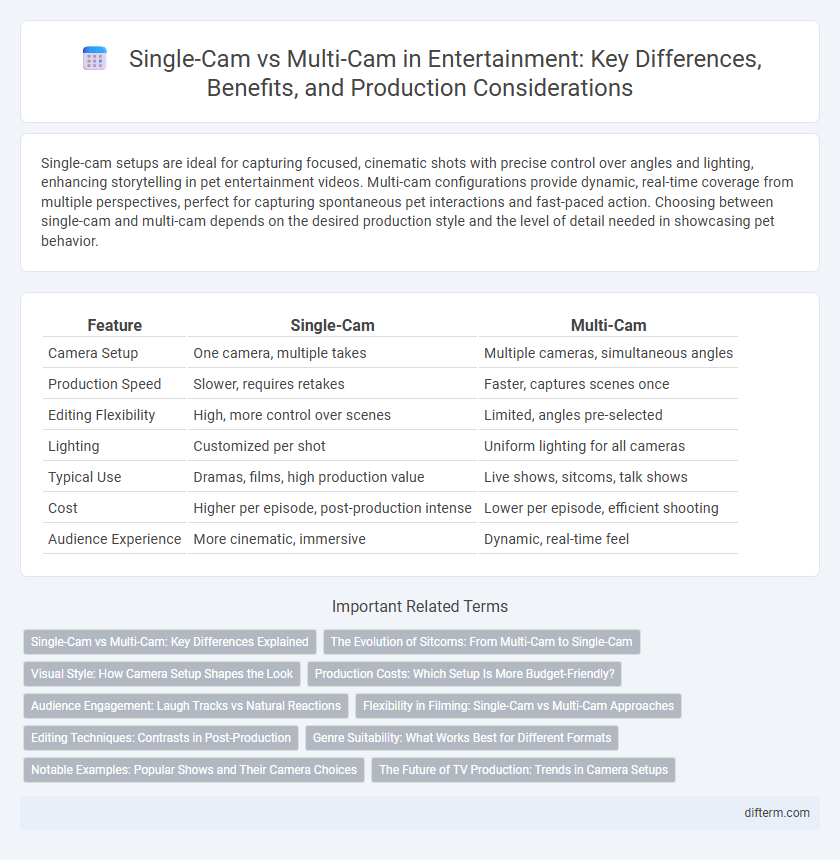Single-cam setups are ideal for capturing focused, cinematic shots with precise control over angles and lighting, enhancing storytelling in pet entertainment videos. Multi-cam configurations provide dynamic, real-time coverage from multiple perspectives, perfect for capturing spontaneous pet interactions and fast-paced action. Choosing between single-cam and multi-cam depends on the desired production style and the level of detail needed in showcasing pet behavior.
Table of Comparison
| Feature | Single-Cam | Multi-Cam |
|---|---|---|
| Camera Setup | One camera, multiple takes | Multiple cameras, simultaneous angles |
| Production Speed | Slower, requires retakes | Faster, captures scenes once |
| Editing Flexibility | High, more control over scenes | Limited, angles pre-selected |
| Lighting | Customized per shot | Uniform lighting for all cameras |
| Typical Use | Dramas, films, high production value | Live shows, sitcoms, talk shows |
| Cost | Higher per episode, post-production intense | Lower per episode, efficient shooting |
| Audience Experience | More cinematic, immersive | Dynamic, real-time feel |
Single-Cam vs Multi-Cam: Key Differences Explained
Single-cam productions utilize one camera to capture scenes, providing more cinematic control over lighting, angles, and editing, commonly seen in dramas and high-budget shows. Multi-cam setups employ multiple cameras simultaneously, enabling faster production speeds and consistent shot coverage, often used in sitcoms and live audience shows. The key differences lie in production style, post-production flexibility, and visual aesthetics, with single-cam offering more creative freedom and multi-cam favoring efficiency and real-time interaction.
The Evolution of Sitcoms: From Multi-Cam to Single-Cam
The evolution of sitcoms reflects a shift from traditional multi-cam formats, characterized by stage-like settings and live audience laughter, to single-cam productions that offer cinematic storytelling and diverse locations. Multi-cam sitcoms like "Friends" rely on multiple camera setups capturing various angles simultaneously, enhancing comedic timing and audience interaction. Single-cam shows such as "The Office" embrace a more naturalistic style with flexible shot compositions, enabling deeper character development and innovative humor techniques.
Visual Style: How Camera Setup Shapes the Look
Single-cam setups offer a cinematic visual style with precise framing and dynamic camera movements, creating a film-like aesthetic ideal for storytelling depth. Multi-cam setups capture scenes from multiple angles simultaneously, producing a consistent, evenly lit look often favored in sitcoms and live audience shows. The choice between single-cam and multi-cam significantly influences lighting, shot composition, and overall visual tone in entertainment productions.
Production Costs: Which Setup Is More Budget-Friendly?
Single-cam productions generally incur higher costs due to longer shoot times and extensive post-production editing required for multiple angles. Multi-cam setups reduce production expenses by capturing several angles simultaneously, minimizing shooting time and streamlining editing processes. Budget-conscious producers often favor multi-cam setups for sitcoms and live events to maximize efficiency and control overall production costs.
Audience Engagement: Laugh Tracks vs Natural Reactions
Single-cam shows often rely on natural reactions from the audience, creating a more authentic and immersive viewing experience that resonates emotionally with viewers. Multi-cam productions frequently use laugh tracks to cue audience responses, which can enhance comedic timing but might feel less genuine to some viewers. The choice between laugh tracks and natural reactions significantly impacts audience engagement by shaping the perceived humor and atmosphere of the show.
Flexibility in Filming: Single-Cam vs Multi-Cam Approaches
Single-cam setups offer greater flexibility in filming by allowing varied camera angles, lighting adjustments, and creative shot compositions, ideal for cinematic storytelling. Multi-cam productions streamline shooting by capturing multiple angles simultaneously, enhancing efficiency but limiting lighting and framing variations. Choosing between single-cam and multi-cam approaches depends on the balance between flexibility in creative direction and the demand for rapid production workflow in entertainment projects.
Editing Techniques: Contrasts in Post-Production
Single-cam editing emphasizes continuity and cinematic techniques, allowing for precise control over pacing, shot composition, and visual storytelling. Multi-cam editing relies on synchronizing multiple camera angles captured simultaneously, facilitating quicker editing workflows and live audience reactions. The contrast highlights single-cam's flexibility in creative effects versus multi-cam's efficiency in capturing real-time performances.
Genre Suitability: What Works Best for Different Formats
Single-camera setups excel in genres like drama, thriller, and cinematic comedies where visual depth, varied locations, and dynamic shot composition enhance storytelling. Multi-camera formats are ideal for sitcoms, talk shows, and live events, providing consistent lighting and quick scene transitions that support fast-paced dialogue and audience interaction. Understanding genre-specific requirements helps producers choose the optimal camera technique to maximize narrative impact and production efficiency.
Notable Examples: Popular Shows and Their Camera Choices
Single-camera setups characterize acclaimed dramas like "Breaking Bad" and comedies such as "The Office," offering cinematic visuals and dynamic scene compositions. Multi-camera formats dominate traditional sitcoms like "Friends" and "The Big Bang Theory," utilizing live audiences to capture instantaneous laughter and reactions. These distinct camera choices significantly influence the pacing, visual style, and audience engagement of popular television shows.
The Future of TV Production: Trends in Camera Setups
The future of TV production increasingly favors hybrid camera setups, combining single-cam's cinematic quality with multi-cam's efficiency to enhance storytelling and production speed. Advances in virtual production and real-time rendering enable rapid scene changes and dynamic angles, pushing the boundaries of traditional single-cam and multi-cam techniques. Emerging trends highlight AI-driven camera automation and VR integration, promising immersive viewer experiences and streamlined workflows in entertainment content creation.
single-cam vs multi-cam Infographic

 difterm.com
difterm.com